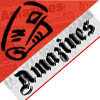|
ARMLS® STAT - May 7, 2013 SALES Month over Month Sales rose in April to 8,755 (7.4%), increasing for the third month in a row. April’s sales figure bests the 12-month average of 7,389 by 18.49% SALES Year over Year Sales in April were up 3.8% over April sales a year ago. The sales increase in April reverses the March to April downward trend of 2011 and 2012. NEW INVENTORY New listings rose 1.8% to 9,870, surpassing the same figure for April 2012 by 7.6%. New inventory in April surpassed the 12 month average by 9.57%. TOTAL INVENTORY Total inventory declined for the third month in a row to 20,083 (-3.1%). Low inventory has stubbornly remained in the approximate 20,000-22,000 range since March 2012. Inventory levels in the 25,000-30,000 range characterized what many considered to be the last “normal’ Valley market. ACTIVESand UCBs STAT has been tracking the Under Contract-Backup (UCB) makeup of active inventory since May 2012. Now with a full 12 month data set, STAT has switched from the former bar graph format to line graph to better depict the trend. After a declining trajectory from May through November 2012, the UCB makeup of active inventory has remained steady in the 18-22% range. This month UCBs of 4,369 ac- count for 22% of Active inventory. MONTHS SUPPLY OF INVENTORY MSI declined for the third month in a row to 2.29. Average MSI for the previous 12 months is 2.95. MSI has remained below 4, which is normally considered a seller’s market, since March 2011. Marketwide MSI should be viewed solely as a barometer of overall market health and has no bearing on MSIs in small market niches. NEW LIST PRICE Both new list price metrics rose slightly in April. Median new list price increased 2.7% to $195,000 and average new list price rose 0.2% to $283,500. Median list price rose 10 out of the last 12 months, while average new list price rose 6 out of the last 12 months. SALES PRICES Both sales price metrics trended upward in April. Median sales price rose 2.7% to $172,000, while aver- age sales price increased 1.9% to $227,900. Since it bottomed out at $151,368 in August 2011, the av- erage sales price has gained 50.53% from that lowest figure, or 2.53% gain per month from the bottom to the current average. The median sales price, which hit its lowest level ($108,000)in May 2011, has gained back 58.82% from that low, or an average of 2.56% per month. Pricing gains, best characterized as slow and steady, over the last 20 months for median and 23 months for the average, have added $76,484 to the average sales price and $63,700 to the median sales price. But when measured from the market highs from which they tumbled ($350,400 in May 2007 for the average and $255,000 in June 2007 for the median), average sales price has gained back 33.57%, or 1.68% per month, and median sales price has gained back 37.03% of what was lost, or 1.61% per month . THE ARMLS PENDING PRICE INDEX™ The Pending Price Index (PPI) is a metric unique to ARMLS which uses pending sales data inside MLS to forecast sales price metrics 30 days into the future. In March, PPI predicted the median sales price to land at $170,000, missing the actual median sales price of $172,000 by 1.18%. Last month’s prediction of $227,200 for the average sales price missed the actual figure of $227,900 by only 0.31%. The May PPI predicts next month’s median sales price to be $173,000 and the average sales to come in at $235,100. PPI SUPPLEMENT The PPI Supplement focuses on the makeup of newly pended properties added to the pending pool each month over a rolling four months. The makeup of properties in the lower, more affordable price ranges ($150,000 and below) as a percentage of total monthly new pendings has been trending lower for some time. This month’s PPI reports that pendings in that $150K and below range make up 37.05% of the total new pendings in April. This contrasts with the same metric from a year ago which was 52.81%. PPI also reports gains in the $250,001-$300,000 and $300,001 to $350,000 over each of the last four months. PPI SUPPLEMENT - $/SQ FT The PPI - $/SQ FT report examines incremental gains and losses in the price per square foot of newly pended properties, added to the pending pool each month on a rolling four month basis. This month, the Supplement shows no significant change in the $/SQ FT trending in any price range. FORECLOSURES PENDING Foreclosures pending continued its downward trending in April to cross the 10,000 threshold, landing at 9,424. The market has not seen this level of foreclosures pending since September- October 2007 on its run up to the all time high of 50,568 in November 2009. If the current fore- closures pending trend line continues on it same downward trajectory, foreclosures pending could enter the 5,000 range by mid Q3 or Q4. Foreclosures pending in the 5,000 range is considered by many to be typical of a normal market. DISTRESSED SALES The distressed sales percentage of total sales fell again for the fourth month in a row, and for the ninth month out of the last 12, to 24.1%. Distressed sales, the composite of short sales and lender owned sales, reached a high of 70.7% of total sales in February 2011. The fallout from the undue influence of distressed properties has been the pricing plummet from 2008 to 2011. The continued decline of distressed sales bodes well for the long awaited pricing rebound. Lender owned sales (992) accounted for 11.3% of total sales and short sales (1,116 )accounted for 12.7%. AVERAGE DAYS ON MARKET (DOM) Average DOM fell by three days to land at 70 in April. The 12-month average DOM is 73. Marketwide DOM is reported as a barometer of overall market health and should not be used to estimate DOM in small market niches. COMMENTARY Good news in STAT metrics this month is grounds for optimism. Sales rose 7.4% in April for the third month in a row, and beat out the 12-month average monthly sales figure by 18.49%. Not bad for a mar- ket that is very short on inventory. All four pricing metrics showed positive gains, continuing the steadily upward, tortoise pace begun in mid 2011. The influence of distressed sales on total sales continues to wane, having fallen from a high of 70.7% of total sales in February 2011 to the current 24.1%. Foreclosures pending, which have been declining since their high of 50,568 in November 2009, dropped in April to 9,424, crossing the psychological threshold of 10,000 for the first time since 2007. On the economic front, the US unemployment rate dropped to 7.5% with the addition of 165,000 new jobs in April, scoring the lowest unemployment figure since December 2008. The Bureau of Labor Statistics revised upwards their estimations for February (from 268,000 to 332,000) and March (from 88,000 to 138,000), accounting for an additional 114,000 new jobs. In addition, the latest unemployment figures for large metropolitan areas show Phoenix as 19th at 6.5% . The reaction to the US employment figures sent the stock market soaring briefly over the psychological barrier of 15,000 on the Dow, with the S&P 500 hitting 1,600 for the first time and the Nasdaq rising 1.1% to end at the highest level since November 2000. Inventory levels remain a problem for the Valley, though new construction is gaining traction. In 2011 the Phoenix new home market logged 6,630 starts, followed by 2012’s 11,102 starts, with the southeast Valley accounting for 37% of those in 2012, with Gilbert in the lead. When comparing the first quarter of 2012 to the same quarter in 2013, Phoenix’s central market area saw the largest increase in starts, increasing 95% from 173 units to 338 units. So far this year there have been 2,462 verified new starts in the first quarter. New construction brings new jobs plus new consumer spending, as well as more inventory. Still unknown is the effect of the sequester on job growth and the economy. Some believe that the econ- omy is unfazed by the cuts and point to the current job growth report as proof. Still others say it’s too early to tell as many of the arbitrary cuts have not been implemented yet. Perhaps more telling is the fact that the Federal Reserve blames the budget cuts arbitrarily imposed by Congress for the holding back the economy. The Federal Open Markets Committee issued a statement that despite the signs of recovery, “fiscal policy is restraining economic growth” and hampering the US’s fragile economic recovery. Phoenix’s economy, tied to the defense industry, is particularly vulnerable. As the sequester is fully implemented in the coming months, the damage may be hard to measure since there is no way to really account for the “what-could-have-been factor” had the cuts been implemented using a more rational approach. But perhaps Congress will surprise us all and engage in meaningful dialogue to make carefully thought out cuts that will minimize the harm, and allow the recovery to flourish and maybe pigs will fly. Maureen Karpinski Find your Phoenix Arizona Property at Cactus Country Arizona Homes & Properties
Related Articles -
Phoenix Properties, AZ Real Estate, Scottsdale Golf Communities, Phoenix Realtors, Scottsdale Homes For Sale, Phoenix Homes for Sale, Scottsdale Relo,
|



















